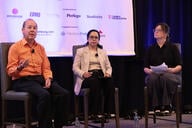You have /5 articles left.
Sign up for a free account or log in.
Many presidents at minority-serving institutions engage with students in a relatively limited number of ways -- mostly photo opportunities, hosting service events like food drives and at social activities like sporting events and student government meetings, according to a new report released Tuesday by the Penn Center for Minority Serving Institutions.
Presidents are often missing opportunities to connect with students, supporters and other constituencies through social media use, the report found. Just 36 percent of presidents at minority-serving institutions use social media, which is far below the 55 percent of all college and university presidents who do so.
The report recommends ways for presidents to boost student engagement through social media: create an account, prioritize having a social media presence, diversify the type of content posted, have a social media team to post when a president’s busy schedule pulls him or her away from social media, follow students’ accounts, and use the medium to provide a glimpse of a president’s personal life.
Other recommendations focus on engaging students elsewhere: have presidents monitor student suggestions submitted online, listen to students during one-on-one sessions or at events, offer public support when students engage in social justice-related activities, engage students when tragedy strikes and be more transparent about the roles presidents play on campus.
Walter Kimbrough, president of Dillard University, wrote in the report’s forward about his experience surveying students about engagement efforts. The second-lowest-rated strategy -- off-campus lunches with freshmen -- also came back as the activity students were most likely to want to be preserved.
“Clearly, there are mixed messages at least on my campus about how students want to be engaged and what is effective,” Kimbrough wrote. “Some of the most effective engagement activities were really transactional (i.e. providing free tickets to events, e-mails about opportunities). But what I learned is that there really is no research available that seeks to study how presidents can best engage their students.”
The report is intended to offer ideas and spur conversations about the best strategies for engaging students, Kimbrough added.




